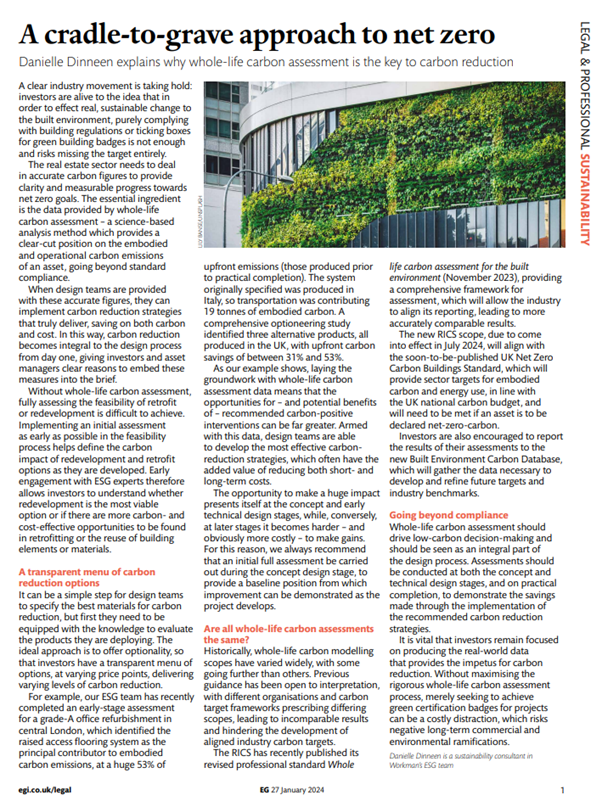Undertaking whole life carbon assessments at the planning stages of a project embeds carbon reduction into the design process for both retrofit and development projects. Danielle Dinneen, Sustainability Consultant, and whole-life carbon-modelling expert within Workman’s ESG team, explains why this early work is key to carbon reduction in this article for EG.
A clear industry movement is taking hold: investors are alive to the idea that in order to effect real, positive, and sustainable change to the built environment, purely complying with building regulations or ticking boxes for green building badges is not enough, and risks missing the target entirely.
The real estate sector needs to be dealing in accurate carbon figures to provide clarity and measurable progress towards Net Zero goals. The essential ingredient is the data provided by whole-life carbon assessment; a science-based analysis method which provides a clear-cut position on the embodied and operational carbon emissions of an asset, going beyond standard compliance.
When design teams are provided with these accurate figures, they can implement carbon reduction strategies that truly deliver, saving on both carbon and cost. In this way, carbon reduction becomes integral to the design process from day one, giving investors and asset managers clear reasons to embed these measures into the brief.
Without whole life carbon assessment, fully assessing the feasibility of retrofit or redevelopment simply cannot be achieved. Implementing an initial assessment as early as possible in the feasibility process helps define the carbon impacts of redevelopment and retrofit options as they are developed. Early engagement with ESG experts therefore allows investors to understand whether redevelopment is the most viable option, or if there are more carbon- and cost-effective opportunities to be found in retrofitting or the reuse of building elements or materials.
“A transparent menu of carbon reduction options”
It can be a simple step for design teams to specify the best materials for carbon reduction, but first they need to be equipped with the knowledge to evaluate the products they’re deploying. The ideal approach is to offer optionality, so that investors have a transparent menu of options at varying price points, delivering varying levels of carbon reduction.
For example, our ESG team has recently completed an early-stage assessment for a grade-A office refurbishment in Central London, which identified the raised access flooring system as the principal contributor to embodied carbon emissions, at a huge 53% of upfront emissions (those produced prior to practical completion). The system originally specified was produced in Italy, so transportation was contributing 19 tonnes of embodied carbon. A comprehensive optioneering study identified three alternative products, all produced in the UK, with upfront carbon savings of between 31% and 53%.
As our example shows, laying the groundwork with whole-life carbon assessment data means the opportunities for – and potential benefits of – recommended carbon-positive interventions can be far greater. Armed with this data, design teams are able to develop the most effective carbon-reduction strategies, which often have the added value of reducing both short and long-term costs.
The opportunity to make a huge impact presents itself at the concept and early technical design stages, but conversely, at later stages it becomes harder – and obviously more costly – to make gains. For this reason, we always recommend that an initial full assessment be carried out during the concept-design stage, to provide a baseline position from which improvement can be demonstrated as the project develops.
Are all whole-life carbon assessments the same?
Historically, whole life carbon modelling scopes have varied widely, with some going further than others. Previous guidance has been open to interpretation, with different organisations and carbon target frameworks prescribing differing scopes, leading to incomparable results, and hindering the development of aligned industry carbon targets.
The RICS has recently published its revised Professional Statement on Whole Life Carbon Assessment for The Built Environment, providing a comprehensive framework for assessment, which will allow the industry to align its reporting, leading to more accurately comparable results.
The new RICS scope, which came into effect on 1st July 2024, is designed to align with the soon-to-be-published UK Net Zero Carbon Buildings Standard (NZCBS), which will provide sector targets for embodied carbon and energy use, in line with the UK national carbon budget, and will need to be met if an asset is to be declared Net Zero carbon.
Investors are also encouraged to report the results of their assessments to the new Built Environment Carbon Database (BECD), which will gather the data necessary to develop and refine future targets and industry benchmarks.
Going beyond compliance
Whole-life carbon assessment should drive low-carbon decision-making and should be seen as an integral part of the design process. Assessments should be conducted at both the concept and technical design stages, and upon practical completion, to demonstrate the savings made through the implementation of the recommended carbon reduction strategies.
It’s vital that investors remain focused on producing the real-world data that provides the impetus for carbon reduction. Without maximising the rigorous whole-life carbon assessment process, merely seeking to achieve green certification badges for projects can be a costly distraction, which risks negative long-term commercial and environmental ramifications.
A version of this article first appeared in EG here: https://bit.ly/3HyCjds

Danielle Dinneen has extensive experience in modelling carbon emissions and producing whole-life carbon assessments within the built environment. Danielle holds an MSc in Green Building, along with a BSc in Architectural Technology & Design.




